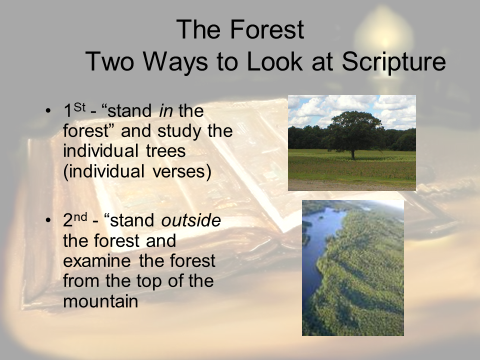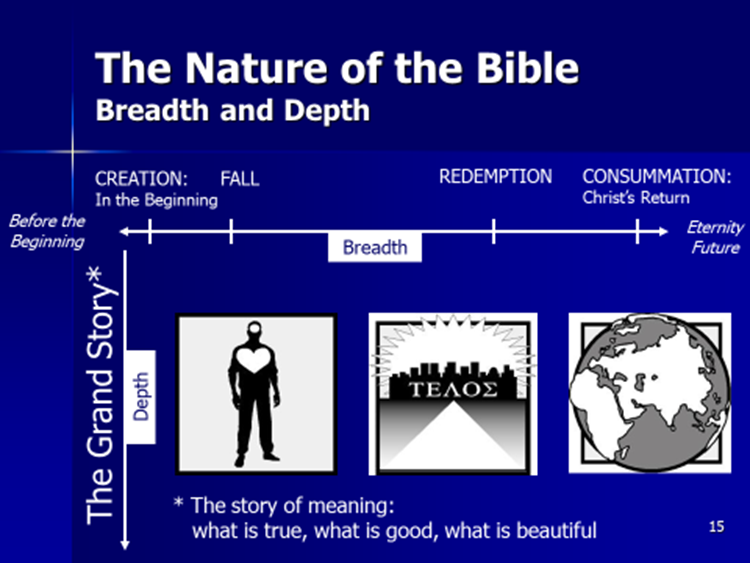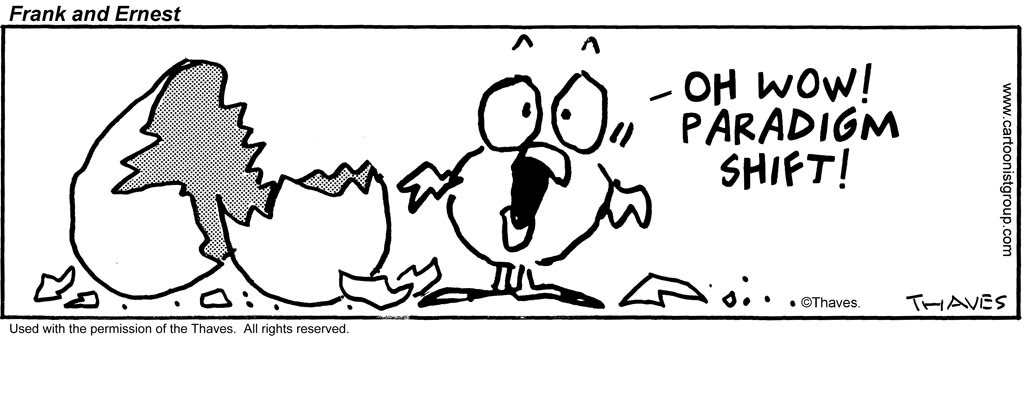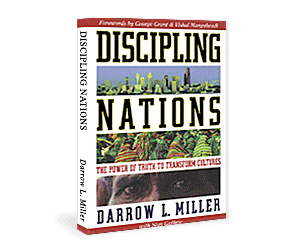How should we read the Bible?
Recently, a reader asked for “chapter and verse” to support an argument I had made in a post. That’s a fair question, and it prompted this post.
Asking for a scriptural reference for a Christian’s statement is always appropriate. Sometimes we read the Bible as a devotional, or study a particular issue by examining a particular reference. You could call that the “chapter and verse” approach. It is fundamental that we establish our thoughts, arguments and lives in Scripture. But I would argue that simply using a proof text for a position is not sufficient.
The Bible as a forest
Picture the Bible as a forest. A forest can be studied two ways: from the inside and from the outside. To study from the “inside” of the forest we examine  individual trees or clusters of trees. This is a good way to study the forest.
individual trees or clusters of trees. This is a good way to study the forest.
But another perspective for studying a forest is from the outside, from a mountain overlooking the forest. Here one can see the contours of the forest. Where are the meadows? Where are the rock outcroppings? Where are the lakes and rivers? This gives a very different and vital view of the same forest.
The same is true for the Scripture. We need to study it from the inside, looking at individual texts, and from the outside, studying the contours of the whole.
Before we continue, let’s outline five basic assumptions of Bible study. These deserve unpacking but that will have to wait for another time.
- An infinite, personal God as revealed in the Bible has always been.
- He revealed Himself through His works and His Word.
- He has revealed Himself in the Scriptures, truly but not exhaustively.
- The Holy Spirit used human beings to record the Scripture.
- The Bible is Christocentric; the entire Biblical narrative leads to Jesus Christ, the Word become flesh.
Now let’s look first at the view from inside the forest and then look from the outside.
Inside the forest
Several principles guide the study of an individual verse of Scripture. The first is to focus is on the text itself and answer three basic questions:
- What does it say?
- What does it mean?
- How does it apply?
The first two questions deal with what Bible scholars call exegesis, bringing out of the text “the meaning the writer intended to convey and which their readers were expected to gather from it.” The third question deals with what scholars call exposition, revealing the text’s relevance to people today in their own cultural setting.
Too often people will seek to answer the third question—How does it apply?—without doing the work to answer the first two questions. This can lead to ignorance and confusion.
Another critical principle is that the Bible interprets itself. An individual text always comes in a context, five levels of context, in fact: 1) The immediately surrounding verses, 2) The book itself, 3) Other books by the same author (Moses or Paul, for example), 4) The given testament, Old or New, 5), The entire Scripture. Per the graphic, every verse has a radius of larger and larger contexts of understanding.
Outside the Forest
A forest viewed from the outside looks completely different than from the inside. The outside view captures the big picture. In terms of Scripture, this is the metanarrative, the big story, the biblical worldview. The following graphic may help us begin to understand this big picture of the Scripture.
Note the Bible is not comprised simply of individual verses. It has both a breadth and a depth.
The breadth of the Bible is the narrative from Genesis to Revelation. The story is outlined by Creation, Fall, Redemption and Consummation. The creation tells us where we came from and why we are here. The fall tells us what went wrong, why are things such a mess. Redemption reveals how God has begun to fix that which has been broken, beginning with the sin rooted deeply in the human heart. The consummation tells us how history will end and thus the context within which we are to live our lives.
Every philosophy and religion is obliged to answer these basic questions: What is true? What is wrong? How can it be fixed? Where is history going ? If you remember these four words—Creation, Fall, Redemption, Consummation —you can unpack them to answer anyone who asks, What is the Bible all about?
The depth of the Bible
Then there is the depth of Scripture. It gives us not simply the flow of biblical history (the breadth) but the meaning of the story. The depth answers the perpetual questions people wrestle with throughout their lives, the worldview questions.
- Does God exist and what is His nature? Or is there no God, per atheism? Or many gods, per animism?
- What is man? Is man, both female and male, imago Dei? Or is man a mere animal per evolutionism, or merely a spirit, as animistic cultures teach? Are women made in the image of God and therefore morally equal to man, or are they inferior to men as sexist cultures teach?
- Is history going somewhere? Or does history go nowhere as animistic cultures teach? Is life on a wheel? Is death the end of human existence, as atheism teaches? When we die, do we cease to exist? Is there no life after we die?
- Do human beings have free moral agency and the ability to affect history, or are we, as atheists say, merely complex bodies of electrical and chemical impulses who are not responsible for their actions? Or, as the animistic culture say, are we controlled by the spirits?
Most of the biblical worldview is laid down in the first three chapters of Genesis. This is why it is wise to study these chapter, and important for pastors to teach them.
It’s also important to read the Scripture, at least once in a lifetime, from Genesis to Revelation. Doing so helps us understand some of the recurring themes of the Scripture.
Not only “chapter and verse”
So, yes, it is important to ask for “chapter and verse” to understand an issue. But there is a different perspective, equally important, and that is to understand the world and life perspective of the biblical worldview.
Let us be students of the Scriptures within the forest, study particular trees, and let us also get on the mountain and look at the big contours of the forest from the outside.
- Darrow Miller








